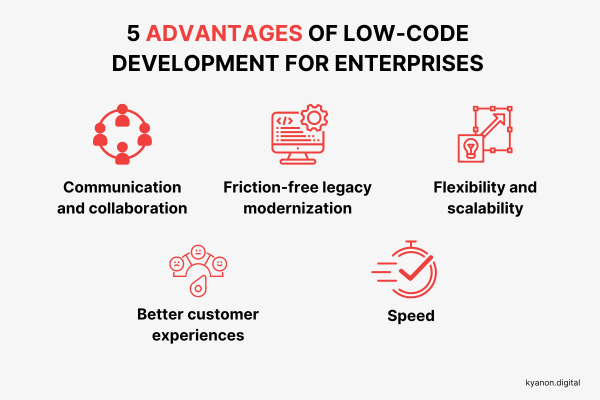Good Reasons On Picking Legacy application modernization with Low-code
Good Reasons On Picking Legacy application modernization with Low-code
Blog Article
Benefits Of Low-Code Application Development For Developers Who Are Not Developers.
Because of a variety of factors, Low-code Application Development is available to non-developers. They are also referred to as "citizen designers."
Drag-and-Drop Builders: Low code platforms come with drag-and-drop interfaces that allow non-developers to develop applications without needing to write any code. This makes development easier for those with no technical background.
WYSIWYG editor: "What you see is the result you will get" editors allow users to create interfaces, workflows and other functions in a manner that is similar to the final outcome. They are easier to comprehend and make use of.
Simplified Logic Design and Workflow Design
Visual Workflow Modeling: Users can create business processes and application logic using visual flowcharts and models that are easier to understand than the traditional methods of coding.
Pre-built Components for Logic: Low-code platforms typically include pre-built logic (e.g. loops, conditional statement) which can be easily configured, reducing a need for complex programming.
Reusable Components and Templates
Library of Templates pre-built: A lot of platforms that allow low-code have templates available that are suitable for most applications. This allows developers to begin their journey quickly and effortlessly and non-developers to modify the templates however they see fit.
Reusable Widgets and Modules: Users can make use of reused widgets. This allows for a simpler creation and eliminates the requirement for extensive knowledge.
Guided Development and Tutorials
Step-by-Step guide: Platforms provide instructions and help on screen to non-developers working on applications.
Interactive Tutorials. Interactive, hands-on tutorials let users learn by doing.
Integration with tools already in use:
Integration seamless Low-code platforms are created to be able to seamlessly integrate with existing business systems and tools (e.g. CRM, ERP) allowing non-developers create applications that fit into their workflows.
APIs Connectors: APIs are built into applications to simplify integration. This allows non-programmers who do not have coding abilities, to connect to external services.
Collaboration Features:
Team Collaboration: Real-time collaboration, shared workspaces, and shared workspaces enable business analysts, non-developers and other stakeholders to effectively work alongside professional developers.
Role-based Access Control: Non developers are able to be assigned certain roles with the appropriate access levels. This allows them to contribute to development without compromising security and performance.
Automated Debugging and Testing:
Test tools are included: Many low-code platforms come with built-in debugging and testing tools. These tools automatize the process, making it easy for non-developers to ensure their applications are working correctly.
Error Highlighting: When issues occur, the system highlights the issue and offers solutions, while guiding users through troubleshooting.
The ability of low-code applications to allow development for non-developers is its biggest advantage. Through providing intuitive, visually-guided tools and experiences, low code platforms let business owners actively take part in and manage applications. Have a look at the top rated Low-code Platform for application development hints for more tips including rad development, software for app development, azure sql databases, jdbc server, no code platforms, multiplatform mobile app development, azure sql, ms azure sql, push notifications, driver jdbc and more.
Advantages Of Low-Code Application Development In Terms Of Cost-Efficiency
Low-code application development offers numerous advantages when it comes to cost-efficiency which makes it a desirable alternative for companies seeking to optimize their development budgets while still delivering top-quality software. Here are some of the main advantages:
Lower Coding Requirement: Low coding platforms eliminate the requirement to write code manually, saving developers both time as well as money. This means lower labor costs.
We require fewer resources for developers. Programming low-code is easier and faster and therefore there are fewer developers who have specialized knowledge are required. The cost of hiring and staffing could be drastically reduced.
Faster time to market:
Development speed up: Visual development tools as well as pre-built parts provided by platforms that use low-code allow rapid design of applications, which allows companies to get their products on the market quicker. This will result in faster revenue growth and better position in the marketplace.
Rapid prototyping allows businesses to quickly create and test prototypes, thus reducing the amount of time needed in the development stage and allows for quicker iterations that are based on feedback from the users.
Low Maintenance Costs
Due to their modularity as well as common components, applications developed on low-code platforms tend to be more simple to maintain. The ongoing maintenance and support costs are reduced.
Automated Updates Many low-code platforms can be adapted to handling updates and patches in a manner that's both secure and timely. This eliminates the necessity for manual intervention.
Efficient Resource Utilization:
Non-Developer Contributions: Low-code platforms empower businesses and other non-developers to participate in the process of development. This democratization allows businesses to utilize the talents of their employees and decrease their dependency on highly-paid programmers.
Optimized IT Resource Use IT departments will be able concentrate on strategic initiatives, instead of being bogged down in mundane development tasks. This will increase overall productivity and efficiency.
The Scalable Pricing models
Subscription-Based Prices: Many lowcode platforms offer flexible, subscription-based pricing models that grow in line with usage. This lets businesses be able to align their spending with the actual demands and growth while avoiding significant upfront costs.
Pay-Asss-You-Go Option: Some platforms offer pay-as-you-go options that guarantee businesses only pay when they make use of resources. This can be especially beneficial for small and start-up companies with small budgets.
Costs for reduced Third-Party Software:
Built-In Functionalities: Low-code platforms typically come with built-in functions and integrations that eliminate the requirement for third-party software and tools which results in savings on licensing fees and subscription costs.
Pre-Built Intergrations: The ability to use pre-built integrations and pre-built integrations of popular services and system minimizes the need for custom development and saves time and money.
Increased ROI
More efficient return on investment The combination of rapid development, lower costs, and faster time to market mean that companies can achieve a faster ROI (ROI) on their applications.
Increased Agility: Businesses are able to quickly adapt to changes in the market and changing customer needs. This allows them stay relevant and to take advantage of opportunities that come up.
Training costs are cheaper:
User-Friendly Interfaces: The intuitive interfaces and user-friendly functions of low-code platforms reduce the learning curve, making it less necessary to conduct intensive training.
Accessible Resources Low-Code Platforms: Many low-code platforms have extensive training materials, tutorials, and community support, further lessening the requirement for formal education and associated cost.
Streamlined Collaboration:
Enhanced collaboration tools: The integration of collaboration tools enables improved communication between team members and a reduction in project overhead.
Unified Development Environment (UDE): An unified, single development environment streamlines workflows, reducing costs and complexity associated with managing multiple platforms and tools.
Low-code development is cost-effective because it reduces development and maintenance expenses. It also accelerates time to market and optimizes resource usage. Pricing models are flexible. These factors deliver significant financial benefits to business and make low-code a compelling option for organizations who want to make the most of their budgets and create quality, robust, and scalable apps. Follow the most popular Legacy application modernization with Low-code for website recommendations including develop cross platform mobile app, azure sql, cross platform mobile app development, database in azure, application modernization software, app modernization, cross platform mobile development, application modernization software, paas service, rapid app development and more.
The Benefits Of Low-Code Development For Both Community And Vendor
Low-code platform development has many advantages, including support from the vendor and community. This is essential in ensuring successful application development as well as ongoing maintenance and constant improvement. These are the main advantages: Support from vendors
Comprehensive Technical Support:
Support Teams: Most platforms that use low-code provide dedicated support teams to assist with technical problems as well as troubleshooting and advice.
24/7 Support: Some vendors are available 24/7, which is beneficial to businesses operating in multiple time zones.
Training and Onboarding
Structured Training Programs: Many vendors offer structured training courses, including tutorials, webinars, and certification courses, to assist users in getting up to speed quickly.
Customized Onboarding : Many providers offer customized onboarding which assist new customers integrate the platform and tailor it to meet their individual requirements.
Regular updates and enhancements:
Continuous Improvement Lowcode platform providers typically issue regular updates that include new features, performance enhancements and security patches. This ensures that the platform remains current and safe.
Feedback Integration: Vendors incorporate feedback from their users into their design cycles to ensure the platform is continually evolving to meet the ever-changing needs of its users.
Comprehensive Documentation:
Documentation - Detailed: A comprehensive and well-organized documentation that covers everything from basic usage to advanced customisations and is usually available. This lets users tackle problems on their own.
API References In-depth API documentation allows developers to modify applications and connect low-code platforms into other platforms.
Professional Services and Consulting:
Expert Consultation. Vendors provide a variety of consulting services, including the design of architecture, strategic planning and complex platform implementations. They ensure that customers are able to maximize the benefits of their platform.
Custom Development: Certain vendors provide services that permit the development of specific features, or incorporate the features, but they aren't available out of the box.
Community Support
Active User Communities
Forums and Discussion Boards: Numerous low-code platforms have lively online communities that allow users to seek answers, discuss solutions, and work together on the best practices.
Local and virtual user groups, as well as Meetups, offer opportunities for users to discuss their experiences, gain knowledge from other users, and connect with.
Collaboration and Knowledge Sharing:
Community-Contributed Resources: Users often share templates, modules, and extensions that they have developed, which can be reused or adapted by others, accelerating development and innovation.
Crowdsourced Solution Finding: The collective experience and wisdom of a group could be an excellent resource for solving complex issues.
Learning and development:
Community-Led Training: Many communities host training sessions, workshops, and webinars. They are often run by knowledgeable users who offer practical tips as well as advanced techniques.
Online Tutorials: Members of the community make and share a variety of online tutorials, how-tos and tutorials. These tutorials are available to all.
Feedback and Influence
Forums for Product Feedback: These forums often include channels for providing feedback to the manufacturer, which can influence the design of new features and enhancements.
Beta Testing Programs: Members of active communities could be able to be part of beta testing programs that give the opportunity to test new features and a voice in shaping the platform's evolution.
Recognition and Assistance:
Community Recognition Programs: Many vendors have recognition programs that recognize the contribution of active members of their community, including MVP (Most Valuable Professionals) programs.
Support from peers: Community members will often offer peer-support, offering their expertise and guidance to those who may be less experienced. They create a more collaborative environment through encouraging collaboration and a supportive atmosphere.
In the end, the combination of of robust support from the vendor with a vibrant and engaged community results in a comprehensive support eco-system for the development of low-code applications. This ensures that users have the resources, expertise and collaboration opportunities to successfully develop and deploy their applications.